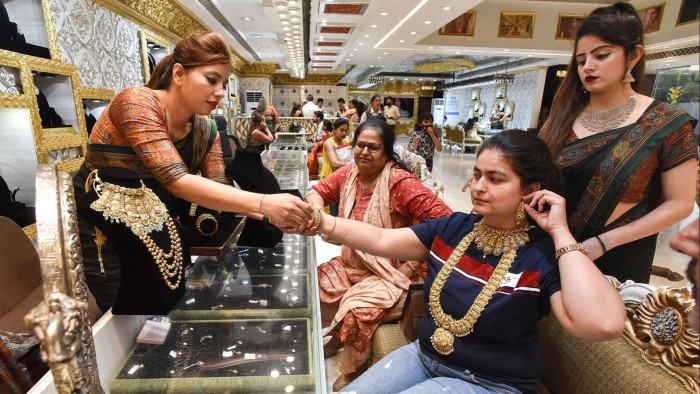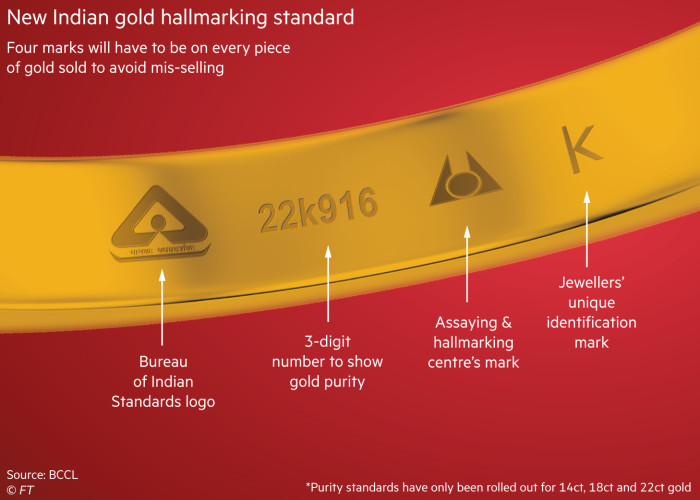Hallmarking brings semblance of order to India’s chaotic gold trading

Roula Khalaf, Editor of the FT, selects her favourite stories in this weekly newsletter.
No one is sure how many jewellers there are in India. The All India Gem and Jewellery Domestic Council (GJC), which represents jewellery retailers in the country, puts the figure at between 300,000 and 350,000. What is certain is the importance of the sector to the country’s economy and its culture. The gem and jewellery market is the second largest in the world, contributing roughly 7.5 per cent to gross domestic product, 15 per cent to merchandise exports, and directly employing 10mn people.
So, when, in June 2021, the government introduced mandatory hallmarking for all gold jewellery into a sector that embraces both the village jeweller in a tiny workshop and the big glossy stores of Mumbai or Delhi — plus everything in between — the challenges were always going to be complex.
The rule change was the culmination of more than a decade of dialogue between the government and the industry. Hallmarking has been voluntary since 2000 but only 30 per cent of jewellery was sold with marks that certify the item as being particular caratage — whether 18ct or 22ct, for instance.
One of the prime movers behind mandatory hallmarking has been the World Gold Council, which believes modernising the sector could boost jewellery exports and give consumers more confidence in the purity of gold they buy.
This issue of trust is at the heart of the new regime and has become more pressing as societal changes affect how, and where, consumers buy their gold jewellery. “While people trust the jewellers, there have also been many, many cases where people always expect — even if it is their own jeweller — that [when] he is telling me [a piece of jewellery] is 22ct, it is really not 22ct,” explains Somasundaram PR, the regional chief executive of WGC’s Indian operations. “The point is I get a benefit that when I go back to him [to sell the piece] he cannot say it is not 22ct.”
“There is not absolute trust in purity and price,” he says, but also notes that gold transactions in rural areas were as close to a banking service as the locals could get. “There was never a bank in those places, so gold was actually a financial inclusion tool.”

Research by the WGC has shown that when consumers go to sell their pieces to a jeweller from whom they have not bought, “80 per cent of them found it was under caratage. It need not necessarily mean the jeweller actually cheated them,” says Somasundaram PR, “it is also possible the bar itself did not have the right standards. But then who do you blame when the entire chain was like this?”
He is referring in particular to the period before 1991, when gold imports to India were banned. At the time, buyers would tolerate impurity by sellers, given the problems of sourcing gold.
Pure, 24ct gold is too soft to withstand wear, so, for jewellery making, it is generally alloyed with other metals. As the Bureau of Indian Standards (BIS), which is overseeing the introduction of the hallmarking regime, points out in a recent briefing paper on mandatory hallmarking: “The need for alloying of gold . . . makes the public extremely vulnerable to excessive adulteration.”
The BIS also acknowledges the complex nature of Indian jewellery, which is mainly made of high caratage gold but with numerous soldered joints of much lower caratage. This makes determining its purity even harder.
In addition, 24ct plating of low caratage jewellery is common. “The consumer, though well aware of such malpractices, still has no option but to submit himself to repeated cheating by unscrupulous traders,” it states.
The hallmarking scheme has been fraught with problems, however. Two months after its launch, most of India’s jewellery stores staged a one-day strike. Jewellers objected to the way the system was being implemented, but their anger was mainly directed at the hallmarking unique ID (HUID). Described by the WGC as potentially “transformative for the jewellery sector”, it is a laser mark that assigns an alphanumerical code to each piece of jewellery, to show the identity of the seller and the assay centre.
Its introduction slowed the hallmarking process down considerably, though, with jewellers unable to sell their pieces without the hallmark. As a result, its scope has been pared back for now, with the HUID imprinted on jewellery and in the digital records of assay centres, but not integrated with the records of jewellers or manufacturers. It is a concession that will please those jewellers that had raised concerns about privacy.
Ashish Pethe, chair of GJC, which helped persuade the government to phase in hallmarking so that infrastructure, including new assay centres, could be put in place first, says that despite the protests, a “large part of the industry has welcomed it [mandatory hallmarking] and embraced it with open arms”.
He points to the 120mn pieces that are expected to be hallmarked this year, up from 50mn before the pandemic.
But the GJC still has concerns, such as problems trading jewellery between districts in the scheme and those yet to be included. There are also worries about penalties for falling foul of the rules.
“In some places, the law states if one of your pieces fails with more than 4 per cent difference in purity declared, your registration can be cancelled. An extreme step and the person can go out of business,” says Pethe.
However, he praises the government response to the industry’s concerns throughout the process and is optimistic these issues will be resolved.
According to WGC, there will be consequences, though. These include increased costs for small retailers in particular — which could lead to consolidation and “a more organised and formal jewellery industry”.
Comments